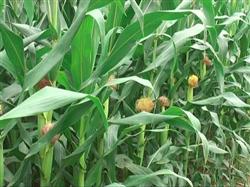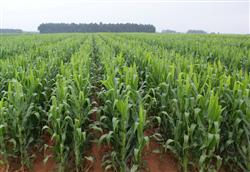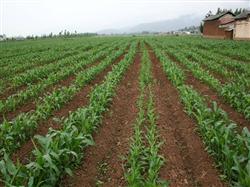How to manage the popcorn period?

How to manage the flowering and grain stage of corn? Please introduce that the flowering and grain stage refers to the stage from heading to maturity of corn. The vegetative growth in this period is basically over, from the vegetative growth and reproductive growth at the panicle stage to the reproductive growth period centered on flowering, fertilization and fruiting, which is the key period for forming yield, determining the number of grains per spike and grain weight. The main goal of this period of management is to maintain roots and protect leaves, prevent premature senility and greed, prolong the functional period of green leaves, prevent grain abortion, and improve seed setting rate and grain weight. The main technical measures of field management are: 1. Apply "attack grain fertilizer" as appropriate. The practice of high yield shows that the large leaf area, high photosynthetic efficiency and long functional period of leaves are the basic guarantee for high yield in the later stage of maize growth. One of the important guarantees of corn green leaf stalk maturity is that there are sufficient inorganic nutrients at flowering and grain stage. Therefore, granulation fertilizer should be applied as appropriate. The so-called discretionary topdressing depends on the appearance of the plants in the field. In fields with sufficient panicle fertilizer, good plant appearance, thick green leaves, and no early decline and light phenomenon, it may not be applied, so as not to prolong the growth period; if the panicle fertilizer is insufficient and the plants are de-fertilized, grain fertilizer should be applied. Attack grain fertilizer is generally applied before and after the female ear flowering stage, combined with watering, 5 kg urea or 10-15 kg ammonium bicarbonate per mu, burrowing and deep application. High-yielding summer maize needs a large amount of fertilizer in the later growth stage, and foliar topdressing can be used to quickly supply the plots that show lack of fertilizer at the filling stage. Foliar spraying with 1%-2% urea solution, 3%-5% calcium superphosphate extract or 0.1%-0.2% potassium dihydrogen phosphate solution during grain filling can prolong the functional period of leaves and increase 1000-grain weight by more than 7%. two。 Go to male in time. Castration can reduce nutrient consumption, promote the transport of nutrients to the female ear, increase light intensity, improve light energy utilization efficiency, reduce plant height, and enhance lodging resistance. at the same time, male removal can also take part of corn borer and aphids out of the field, reduce damage, promote grain development, increase the number of grains per ear and grain weight, and generally increase yield by about 10%. Castration is carried out just before the male ear is taken out, it is easy to bring out the leaves prematurely, reduce the photosynthetic area, and the male ear has flowered and dispersed powder too late, which reduces the effect of male removal. The number of male plants should not exceed half of the total number of plants in the field, not even in rainy days and hot and dry weather, so as to prevent the lack of pollen from affecting pollination and causing sparse grain baldness. 3. Artificial pollination. Artificial pollination can ensure normal pollination and fertilization, increase seed setting rate, reduce baldness and promote grain evenness. Auxiliary pollination has more obvious effect on the plants with late silking and the plots with larger population and more weak plants. Artificial pollination is usually carried out at the end of flowering, at 9: 11 am on a sunny day, pollination is carried out for 2 or 3 times in a row, and attention should be paid to cross-plant pollination. 4. Timely watering and drainage. The flowering and grain stage of corn is the critical period of water demand, during which the water consumption of corn accounts for about 50% of the total water consumption, and the suitable soil water content is 70% to 80% of the maximum water holding capacity in the field. The key water should be irrigated twice in the flowering stage of maize: the first is the key water to promote the number of grains from flowering to grain formation, and the second is the key water to increase grain weight in the milk stage. Irrigation at flowering stage should vary according to soil moisture and be used flexibly, sandy loam and light loam should be increased, clay and loam should be irrigated timely and appropriately, and large population should increase irrigation times and amount of irrigation. In addition, if you encounter too much Rain Water at the flowering and grain stage of corn, you should pay attention to timely drainage. 5. Pull out small plants with empty stalks. There are always a certain number of plants in the corn field that form empty culms or low plants that do not bear ears, which not only consume nutrients and water in vain, but also affect the photosynthesis of other plants. therefore, after pollination, the empty culms and low plants should be pulled out as early as possible, and the limited nutrients and water should be concentrated and supplied to the normal plants, so that their ears have large grains and many seeds. 6. Shallow ploughing and weeding. In order to break soil consolidation, loosen soil ventilation, weed and preserve soil moisture, promote soil nutrient transformation and root absorption, prevent premature senescence and increase grain weight, maize was hoed once in the later stage of grain filling. When shallow hoe, it is necessary to prevent excessive root damage and break the leaves. 7. Control diseases and insect pests. The main diseases and insect pests in the flowering stage of summer corn are corn borer, armyworm, cotton bollworm, aphids, leaf spot and rust. When the silking rate of corn borer reaches 20%, 50% dichlorvos EC is used to drop 600% 800 times the filament base. In the middle and later stage of grain filling, if the corn borer drilled into the female ear, the corn ear was infused with 50% dichlorvos EC or 50% phoxim EC 800-1000 times, 10 ml per plant. Foliar spraying 1500 times of phoxim to control armyworm and cotton bollworm, and 40% omethoate 15002000 times to control aphids. Corn leaf spot was sprayed with 500-fold solution of 50% carbendazim or 70% methyl thiophanate wettable powder. Corn rust can be sprayed with 20% fenrust EC 75ml / mu and 50kg water per mu. 8. Harvest at the right time. The outer phase of mature corn is characterized by loose discoloration of bracts, hardening of grains and bright cortex. There is a black layer on the section where the grain meets the ear axis, which indicates that the corn has entered the full maturity and can be harvested. If the green leaves are good and the growing season allows, the harvest can be postponed for another 5-7 days, which can increase the yield. Click to get more corn planting techniques click to get more food crop planting techniques
- Prev

How to use chemical weeding to grow corn in summer?
How to use chemical weeding to grow corn in summer? Please refer to the following methods for weeding when planting corn in summer: first, according to the investigation of the county plant protection station, the main weeds in summer corn fields in our county are: field spiral flower, sophora officinalis, Rhizoma Scutellariae, Fructus Scutellariae, Portulaca oleracea, Setaria angustifolia, Scutellaria przewalskii, etc. ...
- Next

How to fertilize corn in summer?
How to fertilize corn in summer? Please introduce the method of summer corn planting and fertilization can refer to the following methods: first, avoid excessive fertilizer application. When some farmers grow summer corn, the amount of urea used is more than 50 kg per mu, which will lead to the decline of fertilizer utilization and corn quality, and will pollute the soil. Yes.
Related
- The first cup of black tea in spring, the flavor and history of tea gardens in Kenya, Africa
- The computer can not only choose potatoes, but also grow tea rice. AI will grow winter oolong tea champion.
- It is not only the inflated tea bitten by insects, but also engraved with the four seasons tea in Beipu.
- The Oriental Beauty Tea Festival in Zhuxian County takes the stage at the weekend to experience the plus-size feast of oil tea.
- & quot; Oriental Beauty Tea & Exploration of Emei in Hsinchu, the hometown of quot;
- The new variety of strawberry "Tainong 1" dessert is the first choice with mellow aroma. Crimson gorgeous
- History of Tea in Taiwan: from Wild Inner Mountain to Export Tea Garden
- Two types of Taiwan Oriental Beauty Black Tea won the British three-Star Award for Childhood Tea Xiang Zhang Jiaqi changed from pilot to champion tea maker.
- Banana species and varieties: the planting history of Taiwan Xianren banana and dwarf banana is long, is banana disease resistant?
- Coffee planting Technology: Qianjie Coffee from Seedling to harvesting

